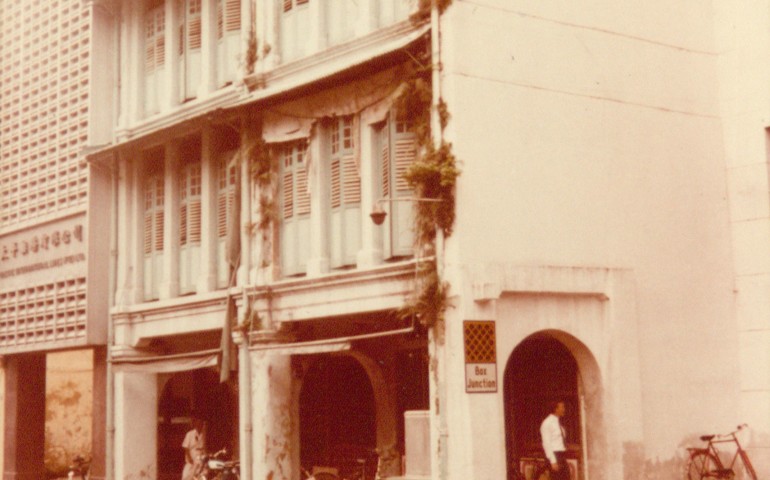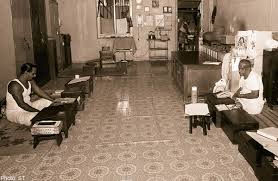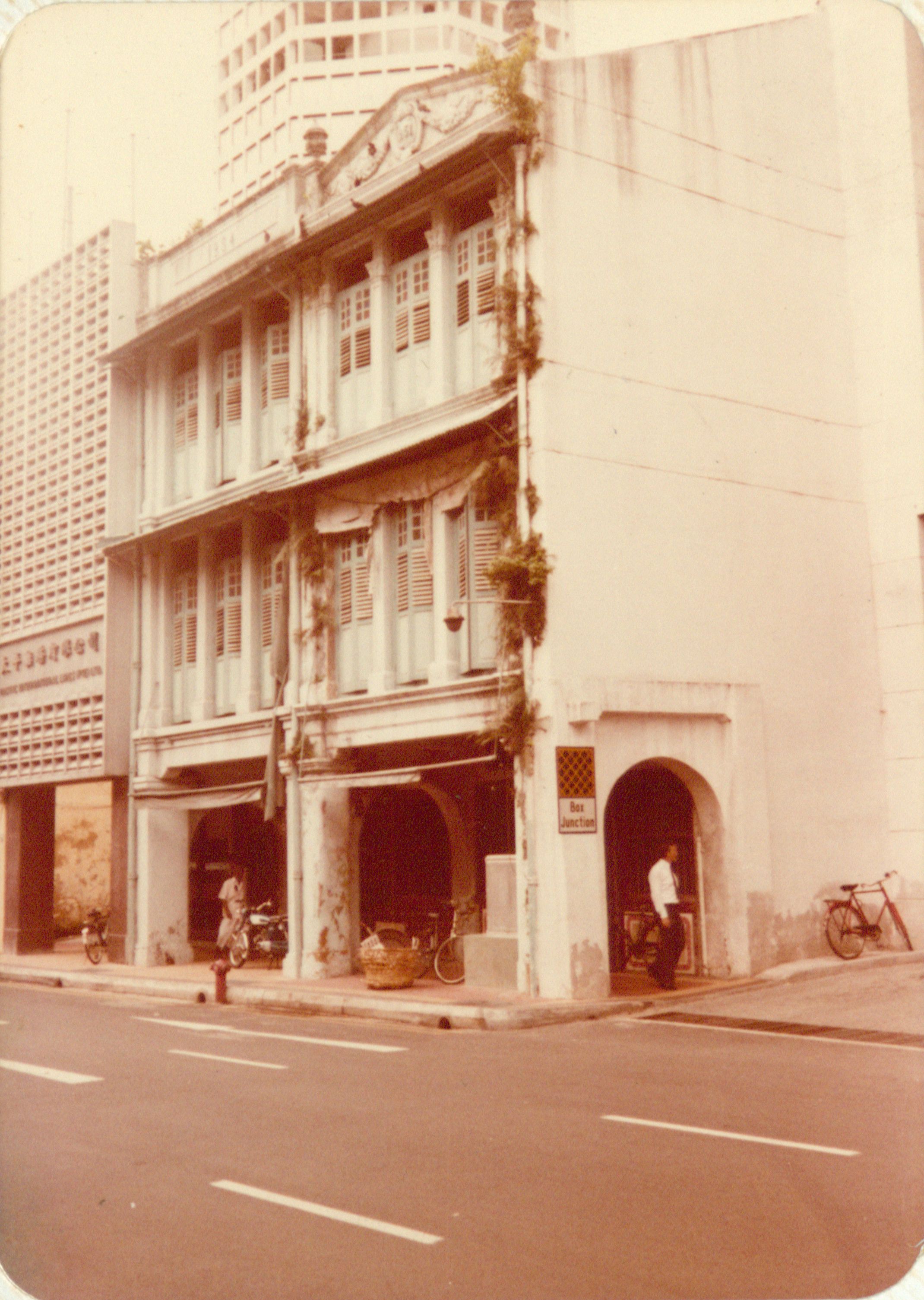Caption for the cover photo: External view of the kittangi
(continuation from the previous issue)
The Kittangi – Pioneer Bank ‘Branches” that Empowered Nagarathars to Succeed Overseas as Private Financiers
Mr Subbiah Lakshmanan
BUSINESS OWNERSHIP
The businesses could be owned in a variety of forms. The most common being the joint family firm where several brothers managed one business under their father or widowed mother. Partnerships were also common, often between Pankalis. The sole-proprietor model with only one owner was also another model. For wealthy owners, there was the full-fledged branch office model. There will be many Kadais spread out in many towns (and even countries) all under the same Vilasam. Each Kadai would be managed by an employed agent who had full profit and loss responsibility and the agent often was also a minority share-holder in the business. It was also common to have agents who were not Chettiars but from the Chettinad region eg. Pillais, Mudaliars, Ambalams, etc.
KITTANGI: THE COMPETITIVE ADVANTAGE
The Kittangi was the primary instrument that provided key competitive advantages for Nagarathars allowing them to go interact with clients and meet their immediate and emerging needs. No matter where the client was, with the vast network of Kittangis, Nagarathars could use such facilities with low overhead costs and provide financial services to clients, advise them and monitor the progress of the client’s business. Organized banks could not do this. Especially the Western banks as their overheads were high and their staff would not be able to live in remote areas with little infrastructure.
The Kittangi structure also supported the long-term presence as a united business community which was larger than the sum of its parts:
- Proximity to customers even in remote areas
- Super low overheads with full sharing of services
- Security even in remote areas
- Networking – they operated as a community
- Cultural integrity –united based on cultural values and proud to be Nagarathars
- No isolation – as they were with their relatives and community members
This arrangement was also critical to keeping the integrity of the community over two centuries. Otherwise the community could have dissipated into inter-cultural marriages melting into the host community.
TEMPLES
Once successful in business, Nagarathars would allocate a certain proportion of their profits (Mahamai), to Lord Muruga and eventually build a Murugan temple. It is estimated that about 120 temples were built in South-east Asia and Sri Lanka between 1850 to 1950. About 110 were Murugan temples and only a few were Sivan or Pillayar temples. This was partly due to the fact that Brahmin priests, who were required for a Sivan temple, would not cross the seas during the 1800s.
VALUES – THE SECRET OF THEIR SUCCESS
Underpinning the Nagarathar business model was a strong value system which the community embellished. These values were developed through a four stage 15 year apprenticeship program starting at the age of about 11 – Podiyan, Adutha Aal, Kootali and Pankali . The key core values that underpinned Kittangi life were:
- Piety – nothing was done without invoking God and a tithe was paid
- Simplicity – Living a simple life was a virtue
- Frugality – Savings was key to building up capital for future business
- Flexibility (Vittu kuduthal) – they lived as a group and harmony was key
- Respect for elders – Elders maintained order in the Kittangi.
The core values that underpinned business success were:
- Honesty – client confidence was instilled by keeping one’s word
- Trustworthiness – owners trusted branch managers to follow instructions diligently despite limited communication
- Unity – they did not undercut each other and acted as a community to increase the size of their collective business by building up the Chettiar “brand” for integrity
This honesty, trustworthiness, unity and disciplined lifestyle were the core values that made the banking system work. This cannot be over-emphasized, it was the software of the Kittangi that was critical and not the hardware.
For example, if an interest rate was set by the major firms in Chennai or Calcutta, all the branches would stick to those rates no matter how remote. And in each town, the Kittangi members would set their street interest rates and everyone would fall in line. Based on this discipline and unity they were able to expand so rapidly as a united force despite the large distances, unreliable communications systems, different cultures, different local languages and colonial jurisdictions. Virginia Thompson writing in 1937 in her book “French Indo-China” (Pg 224)
“They have the advantage of lending money with a minimum of formalities and guarantees. They have almost no running expenses, a great solidarity among themselves and they apportion the interest rate to the material status of the debtor.”
(to be continued)
SUMMARY
The Kittangi was a brilliant innovation and demonstrated how the Chettiars planned and conceived strategies to expand business and overcome challenges. The Kittangi was a precursor of branch banking and telegraphic transfer. For about 180 years this model worked well and gave a good run for the money against banks like HSBC and Standard Chartered Bank. These banks in their official histories mention the Nagarathars as their key competitors and the strategies they used to wrest business away from them. It should be noted that, these institutions are known to have incorporated successful Chettiar practices and financial instruments into their own corporate practices.
Today out of an estimated 400 or so Kittangis worldwide only less than 20 are in a minimally functional condition. The traditional Nagarathar banking business model has been superseded by modern banks which offer easily accessible loands and credit card facilities. However, in Malaysia there are still Kittangis where small scale money lending is still done – Penang, Alor Star, Telok Anson being some of them. In Kuala Lumpur and Singapore Kittangis are still in a good condition but being used for alternate purposes. In Sri Lanka, Burma and smaller towns in Malaysia the Kittangis are in a derelict condition with few or no regular occupants. There is an effort being made in Singapore and Penang to preserve the Kittangis as heritage centres. It is hoped these efforts will bear fruit in the next few years as important heritage of both the host countries and the Nagarathar community.
Like the American pioneers, who journeyed into the Wild West and converted the prairies and deserts into vibrant economic enters, the Nagarathars journeyed into the wilderness of South-East Asia braving the tides of malaria, insecurity, loneliness and uncertainty. They surfaced as pioneers in the banking profession converting jungles into plantations and mines which then in turn grew into prosperous settlements and towns. In the process they established a reputation for piety and honesty and were respected by one and all.
Sir Harcourt Butler, Governor of Burma wrote in 1927 (as quoted in the “Fiery Dragons: The Chettiars in Burma”
“You represent a very important factor indeed in the life of this province…Without the assistance of the Chettiar banking system Burma would never have achieved the wonderful advance of the last 25 to 30 years…The Burman today is a much wealthier man than he was 25 years ago; and for this state of affairs the Chettiar deserves his thanks.”
A British planter in 1900s Ceylon is quoted to have said:
“Hamlets became villages, villages became towns, towns became cities, thanks to Chettiar businesses”
Nagarathars seized the opportunities of the day with great courage, business acumen and most of all a strong value system to generate enormous wealth both for themselves and the host countries. Indeed, even today they are a beacon of inspiration and have left us so much to be proud of.
About the Author
Subbiah Lakshmanan is a Singapore-born Chettiar whose great grandfather started a Kadai in Singapore in 1892. He has been a Financial Controller with various MNCs for over 20 years and he has completed his MBA at UC Berkeley. He has been involved with many Chettiar related heritage projects in Singapore since 1998 including museum exhibits, talks, TV and radio shows, published articles, community education classes, Chettiar statue and MOE history curriculum. His family originates from Kallal and Vairavan Koil and he has 2 teenage children.
Photo Credit
Mr K Varadarajan
Mr N Subbiah Chettiar













No Comment